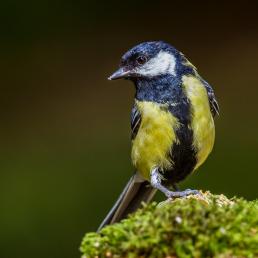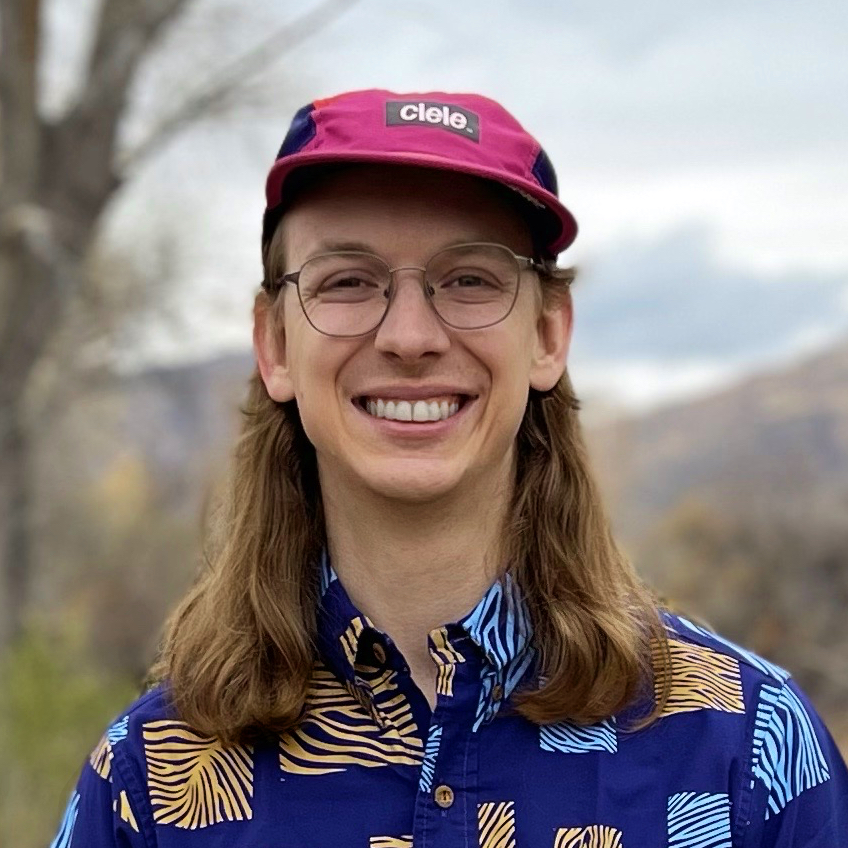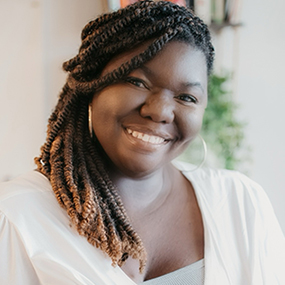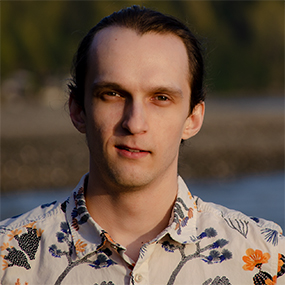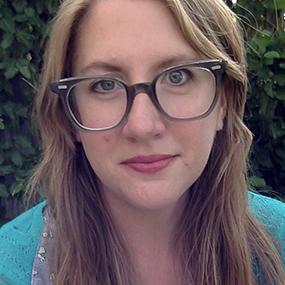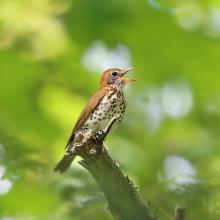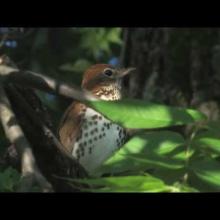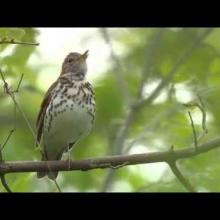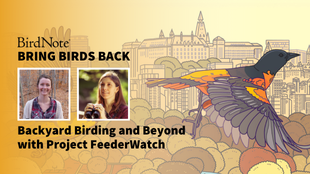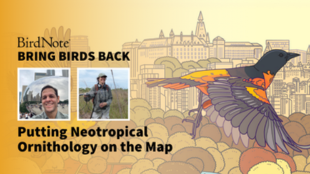

Join BirdNote tomorrow, November 30th!
Illustrator David Sibley and actor H. Jon Benjamin will face off in the bird illustration battle of the century during BirdNote's Year-end Celebration and Auction!

In order for us to show up for birds, we must first show up for ourselves. Our show is all about ways we can help our bird friends, but today we’re looking at how birds and nature can help restore us. Over the past few decades, researchers have found strong links between our connection to the outdoors and our mental and physical health. Deja Perkins, an urban ecologist, science communicator, and friend of the show, joins Tenijah to talk about her nature and wellness practices and some research about the mutual benefits between the two. Deja shares how birding can be good for our wellbeing, ways we can all enjoy those benefits, and even guides us through her very own breathing meditation to help you really sit with nature.
[Calm, uplifting music starts]
Tenijah Hamilton: From BirdNote, this is Bring Birds Back. I'm Tenijah Hamilton.
The world can be… exhausting. For those of us who care about the environment and our bird friends and are trying to protect them, the news can be really disheartening.
Something we really believe in at BirdNote is that we all need a spark of joy for birds and the environment to take action on their behalf — that might mean helping someone new really notice birds for the first time, but it also might be reminding longtime bird nerds why they care in the first place. We need to continually build that connection to nature.
Well, it turns out that this goes even deeper. Over the past few decades, researchers have found strong links between our connection to the outdoors and our mental and physical health — including the benefits of listening to birdsong.
We spend a lot of time on this show looking at how we can help birds, but today, we're looking at how birds and nature can help us. Because we need to take care of our own mental health if we want to be there for the birds.
Deja Perkins: Your mental health is just as important as every other thing going on in your life. You know, maybe even more so, because if your cup isn't full, how can you expect to be able to pour into others and do all the things that life demands of you? So refill your cup.
That’s my guest today, Deja Perkins. She’s an urban ecologist from Chicago with a passion for engaging people with birds and nature in the city, and she’s a PhD student in Geospatial Analysis at North Carolina State University. And she’s also a friend who I know thinks deeply about this connection between nature and wellbeing.
This is the last episode of the season, and we’re entering the time of year with holiday travel and family stress. So to help you manage all that — plus, of course, the stress of being without your favorite podcast for a few months — I wanted to bring Deja on to share some of her wisdom with y’all.
She’s going to share some of the recent research on this subject, and give us practical tips on how to cultivate our relationship with nature. So, Deja, how are you doing today?
Deja Perkins: Hi, Tenijah. I'm so good. Um, I'm excited for today's conversation. How are you doing?
Tenijah Hamilton: I'm pretty good. So when people hear the word meditate, they kind of tend to have a picture of what that means. A very specific picture. Right? But being in nature can also be a practice in meditation.
Deja Perkins: Yeah that’s something that I have to be intentional about doing when I go out walking, in the woods, in the forest, outside wherever I am. In order to be observative about your natural surroundings, you really have to be able to quiet your mind and start picking up on what's going on around you. And one way to do that is through breathwork and meditation.
[Calming but upbeat music begins]
Just an example, one thing that I've started doing recently is called silent hikes. And I go out, to one of my favorite places here in Raleigh and I try and be as quiet as possible. And think about how hard that is and how often we're like walking through the forest and maybe like our footsteps are crunching or like we're breathing really heavy, but when you're just going out, you know, maybe on a silent hike, you're walking, you're trying to make your footsteps as quiet as possible. You're trying to blend in with nature. You're trying to breathe. You're being mindful of your breath and you're breathing in slowly and calmly. You're listening to the sounds around you. You're feeling the warmth of the sunshine on your face. By being more observant about how all of your five senses are being present in the current moment, you're also able to kind of listen in more deeply into like, what are you hearing?
And quieting your mind in that way really helps to relax you and calm you in a way that I haven't really experienced in any other calming attempts. Cause I have really bad anxiety, so I have to go and de-stress and decompress a lot.
[Calming but upbeat music fades out]
Tenijah Hamilton: I'll say, listening to you kind of describe that experience, I'm like, wow, that does sound really nice, which is, uh, not traditionally been my story. So I, I really love this picture that you're painting and really the intentionality behind it, right? Cause you're talking about being— you're there to kind of have a little bit of escapism, but you're being so mindful about how you are in this space and what your presence kind of, holds and signifies, which I think is really cool. So you are a certified bird girl.
Deja Perkins: Yes.
Tenijah Hamilton: And that is one of, um, the main reasons that, I'm sure, draws you to nature. And when I think about birds and outside, and kind of this peaceful experience, I know something culturally, a bird that we think of is doves, right? We think of doves. They're peaceful. I'm curious if you had to designate a bird to represent kind of, peace of mind, what bird would it be?
Deja Perkins: Oh, that's a really tough question. If I think about a bird that, um, represents like peace and brings me to a happy place every single time. It would definitely be the Wood Thrush.
[Wood Thrush song; it sounds ethereal, like a magical flute]
That melodic flute. It just—
[Wood Thrush song]
I can close my eyes and listen to that song and it will transport me to like, some magical place.
[Wood Thrush song]
That sound gets me to stop every single time. No matter what I'm doing, I will stop and listen to the Wood Thrush.
Tenijah Hamilton: As we're kind of talking about birds on a broader spectrum, can you tell me about what you see as some of the mental health benefits of birding?
Deja Perkins: The mental health benefits of birding, in my opinion, is one: getting yourself outside. What I was talking about with the silent hikes and how that allows you to be, um, more observant of your natural surroundings. Like that's a skill that you need for bird watching. And so like a lot of people go birding for a lot of different reasons and some of that could be to just go outside and find joy in what you're seeing. Not necessarily identifying the birds, but just going out and watching the birds go out about and move in the world around you. And it just allows you to kind of get outside of yourself and kind of, I guess, like escapism away from the stressors of your day to day environment.
But that's really just like my personal feelings about it and from my personal experience, but being the researcher that I am, of course, I came here today with some papers and some research.
Tenijah Hamilton: Yes. Please share.
[Slow, almost childlike music begins]
Deja Perkins: So, um, there was a study that came out in 2021 that looked at the relationship between biodiversity and health in the urban environment. And so they found that higher biodiversity is linked to more perceived benefits of happiness and mental health. So the more, the more variety of birds you have, the more variety of like wildlife you have, you know, the more variety of plants that you have in your neighborhood, you perceive that as being a happier, a better place.
And so that's, you know, another reason why it's so important that people have access to natural spaces, no matter where they live, no matter what income level they reside within. It's so important that we have the access to these spaces within our community so that we can have those physical health benefits by just being outside, walking. Getting, you know, vitamin D. You know, the mental health benefits of being outside in nature and just being surrounded by that aesthetically pleasing landscape.
Tenijah Hamilton: There were so many intersections, as you were speaking, with kind of the idea of restoration. And how we can kind of restore these habitats and these environments, especially in more urban areas. And that leads to kind of the restoration of the people there as well, who potentially have not had access to those places before.
[Slow, almost childlike music fades]
So if we're thinking about class, if we're thinking about race, if we're thinking about kind of the urban landscape, it's really imperative, it feels like, to be able to restore some of this biodiversity in green space for a healthier outcome.
Deja Perkins: Yes, 100%. And a lot of the work that I do now going into the geospatial analytics piece, is kind of looking at where are people going bird watching? Where are people who use the eBird app?
eBird is an app that a lot of bird watchers use to record and keep their lists. And that app has publicly available data that researchers like me can use to look at a lot of different things. It's been used to make policy changes. It's been used to list birds on the IUCN red list.
Tenijah Hamilton: Just going to cut in here — that’s the list biologists use to keep track of which species are at the greatest risk of extinction, and which ones might become endangered soon.
Deja Perkins: Yes. It has been used for an abundance of things, and I'm using it to look at where are people going bird watching?
And we've seen that people are oversampling these higher income areas and undersampling low income areas. And there have been other studies that have come out showing that people don't really sample red lined areas either. Just like how red line areas have less tree cover.
Areas that are deemed as degraded or, you know, hazardous in the past, they'll still have less tree cover and less bird observations than other places. And so it's so important that we go out and go birding in our own neighborhoods and see what's out there and get more familiar with, you know, the nature that we have right there in our neighborhood.
Tenijah Hamilton: And for listeners who might not know, you mentioned redlining — and that’s the discriminatory practice of denying mortgages, loans, and other kinds of development or community investment in areas with a lot of people of color and/or folks from low-income backgrounds. And so for people from marginalized communities, who are already on the frontline of issues like climate change and environmental racism, there’s often a systematic and intentional lack of greenspace like parks, which means fewer trees to see birds in.
So as we're thinking about birding and how that in itself can be restorative, there are different kinds of bird excursions, right? And you can do it for different reasons. So I'm interested in how you kind of set the stage for a birding experience that's very intentional about your mental health, versus a birding experience where, I don't know, maybe you're going with friends or maybe you're going to capture photos. Like I'm really interested on how that differs.
Deja Perkins: Yeah, sure. Birding for mental health, a lot of that is solo. It's gonna be individual. Honestly, when I go birding for mental health, I usually do not make a list of what I'm seeing.
If I see something really cool, then yes, I'll start a list. But, um, prior to that, I am, I'm mostly, like, birding by ear personally. I'm, I'm listening and allowing that to kind of connect me to the space.
[An evening chorus of birds, reminiscent of a flowing river]
Because maybe in this instance, like my mind is running a bit and I'm thinking and replaying different situations.
You know, I'm focusing on my breath more, I'm breathing in, you know, that fresh air. And like I said, I'm listening to my surroundings and trying to, you know, think about what birds I'm hearing. You know, these walks may be a little bit longer. You might sit outside in a sunny spot and just observe and just listen and just be present. And maybe you meditate a little bit. You're not necessarily focused on the birds, but you can use the birds as a tool, almost, to relax yourself.
A tool to help you escape the chaos of your mind, but you're not so focused on the birds that you are just kind of not connecting with your own emotions and yourself in the present moment.
[The evening chorus begins to fade]
Tenijah Hamilton: It sounds like what you're saying is so much of: let the experience take you where it's gonna take you versus coming with an itinerary and a checklist. Kind of, go with what happens out there. Because it seems like so much of other birding experiences have to do with engaging your mind in a very active way.
And it seems like right now you're really advocating for: nope, the opposite. Like, let, let the outdoors engage you.
Deja Perkins: Exactly. Exactly.
[Thematic, driving music enters]
Tenijah Hamilton: After the break, we’ll get into the idea of the outdoors as a safe space, how to kickstart your own nature/wellness journey, and dig into some of the breathwork Deja’s been talking about. Be Right back.
[Music fades out]
Tenijah Hamilton: And we’re back. So Deja, I'm curious about the ways that you think of outside as a safe space. And one that has kind of these restorative properties. In my experience, it's still something that I'm coming around to. And I really struggle with the idea that being outside doesn't necessarily always feel safe. I grew up for a big part of my life in New York City. And I remember when I used to come down to the south for the summers, being so thrown off by hearing crickets at night. Like, and I couldn't sleep. I couldn't really feel that kind of peace with nature in its natural state. And I'm also acutely aware of how I show up and how I present in the world. I am a woman. And I am a Black woman, as you are. And I'm curious about the safety of the outdoors and how you make sure you prioritize that as well as kind of the incredible benefits that you've been speaking about.
Deja Perkins: Now that is a really great question because I also don't feel safe in every outdoor space that I'm in. I travel a lot. Like I currently live in Raleigh, but I'm from Chicago. So I go and visit often. I have lived in Alabama. I've lived in Mississippi. I've lived in a lot of different places and not every green space, not every park is a place that I would go to do these silent hikes or practice my breathwork. Because you have to be able to feel safe to close your eyes, right? So one thing I do when I do these kind of mindful walks or silent hikes, I try and go in places that are, like, off peak time, so not as many people might be there.
Um, another thing I do is I try and find spaces that are again, like, not as, high traffic. So maybe a park that isn't as urban. Like maybe for these hikes, you do have to go somewhere that is a little bit more remote. But maybe if you don't feel safe in a more remote location, maybe it's about finding a space within um, your local park that you do feel safe.
Like maybe there is like a little hidden little nook somewhere. Maybe you're going someplace like a botanical garden, which is controlled and has security. And, you know, it's still a natural space, you know, all these beautiful flowers and you can be able to connect and still feel safe.
So it really depends. A lot of it is, you know, you have to explore a little bit. Maybe this is a challenge to explore and find a new space. Like find your park that's going to be your park for your mental health experiences, I guess. Maybe that's what it's about.
Tenijah Hamilton: So much of what you just said is so resonant and so important. And I love what you said about botanical gardens, because I've never thought about it like that. And I've never thought of that as a way to kind of be out in nature. And kind of satiate that part of yourself that wants that exposure, but in a kind of a controlled environment, which I think makes a lot of sense.
And so much of the exploration you're talking about— you're, you know, encouraging folks to explore the natural world, of course, but it also is like a self exploration. Like explore the places internally that are gonna allow you to have this experience because it's an important one.
Deja Perkins: Yeah. And I mean, everybody experiences nature in a different way. So take baby steps.
Like— maybe you start at the botanical garden then maybe you go out to a local park. And then maybe you can even create these spaces for yourself in your own backyard.
You can start to bring in some of that biodiversity. You know, maybe you can find a native plant store and bring in some of the plants that make you feel at peace and plant those in your yard. And at the same time, you're increasing your backyard biodiversity and you could attract birds to your space, you know, through feeders and water and plants and cultivate that peaceful space in your backyard.
It's all about cultivating these spaces where, you know, if we can't find the space, then we have to cultivate it. You know, just like Black Birders Week. We couldn't find the space for us, so we had to build the table. We had to build the space.
Tenijah Hamilton: Absolutely.
Deja Perkins: Our mental health is so important, so we have to do what we have to do to make sure that we protect that for ourselves.
Tenijah Hamilton: Oh man. So profound. And, and in these spaces, and you've called out a couple of different ones, but in the ones that you feel most safe in, what are the commonalities?
Deja Perkins: For me, I feel safe when I am surrounded by trees, but there's kind of like an open canopy, kind of. Um, someplace near water, I always feel safe. Places with lots of flowers for me, cause I like— I could just go and sit in the middle of a flower field and kind of disappear amongst the flowers and feel just kind of like, oh, this is just so nice, like, creating my own little world. But definitely, some place that I'm surrounded by trees and not feeling it as kind of open and exposed.
And I know that may not be the case for everybody, because if you don't have a lot of experience in the forest, trees can make you feel claustrophobic or they can make you feel in the middle of a scary movie. But for me, you know, depending on—
Tenijah Hamilton: Deja, why are you reading me right now.
Deja Perkins: Listen, I know.
Tenijah Hamilton: Why are you reading me?
Deja Perkins: I have family, like, who have that, that same feeling about the outdoors. Like Raleigh is just— there's trees everywhere. And the first time, my family came to visit, they were like, I've never seen so many trees in my life. Like, I feel claustrophobic. It's just trees. So I get it. I get it.
And I will say that I'm still, uh, an urban girl at heart. Like urban ecology. Grew up in the city. Like I prefer urban spaces, so I wanna be able to at least be able to get somewhere if I need help. Like that still plays an important role for me for safety. Like if I can, you know, still get somewhere if something happens and get help, then I feel safe.
Tenijah Hamilton: I love that.
[Upbeat optimistic music]
When I asked Deja for tips about making space for mental health and the outdoors, her biggest piece of advice was pretty simple:
Deja Perkins: Just get outside and go birding.
Tenijah Hamilton: Just do the thing.
Deja Perkins: Just do— just, just go out there. Make time for yourself, you know, put it on your calendar, do whatever you have to do, set an alarm, prioritize you.
Tenijah Hamilton: So to finish today's episode, I want to give us all a chance to take a little baby-step together — Deja's going to guide us through some of her breathing exercises, and we can join in with her. So, find a cozy spot, and here we go:
Deja Perkins: The reason why your breath work is so important is because a lot of things like our stress and our anxiety can be reduced by breathing deeply. It's been shown that increasing your deep breathing and learning how to manipulate your breath can help to get you out of that head space. Really just grounding yourself into the present moment.
There have been times when I've noticed like, oh, okay Deja, you're stressed out. Your, you know, your mind is going a million miles a minute. You know, you're about to kind of start panicking. Let's do some breathing. Let's take a moment, connect with the world around us, and let's focus on our breath.
[A soft wind blows against a canopy of trees]
So let's say we’re out on one of my silent hikes. I try and go to a place that’s not crowded. You know, a place that I know won’t really have a lot of people. Maybe I am walking along the trail at first, kind of, being washed in the sounds of nature.
[A windchime quietly sways in the background]
Deja Perkins: Maybe I stop for a moment and I start with some regular breaths.
[The drone of a singing bowl sneaks in]
[Someone begins to calmly breath in and out a few times]
Deja Perkins: And then I breathe in.
[A singing bowl is gently struck with a soft mallet]
[Breathes in deeply, holding it for 4 seconds]
Deja Perkins: Hold it for 4.
And then I breathe out
[Exhales slowly but intently]
Deja Perkins: Through my mouth, real slow and controlled.
And then I repeat that a few times.
[A singing bowl is struck again]
[Breathes in deeply, holding it for 4 seconds, exhaling out slowly but intently 2 times]
Deja Perkins: All this time, while you’re doing this, your eyes are closed. And so, you’re breathing in. You’re feeling the feel of the sun shine on your skin.
[Breathes in deeply, holding it for 4 seconds, exhaling out slowly but intently]
Deja Perkins: And then you slowly open your eyes, you take another deep breath and you keep on walking.
[Person begins walking somewhere else, and then stops]
And then maybe you find a nice spot on a rock overlooking the lake. And you take a seat.
[Very soft waves wash into a tiny, intimate cove, almost sounds like it’s in a room]
Deja Perkins: You’re making sure your back is straight. And you’re gonna do a little bit of belly breathing. So you’re gonna push that air all the way into your stomach.
[Breathes in with more power]
Deja Perkins: And then you’re gonna force it out through your mouth.
[Exhales with more power]
Deja Perkins: And you’re gonna do that a few times, focusing on that one type of breath.
[Singing bowl is struck again]
[Breathes in with power, exhales with power, repeated 3 times]
Deja Perkins: And then you're gonna place your hand on your stomach. And you're gonna focus on trying to push that breath back into your back and really open up your diaphragm. It's really going to restrict your ability to move that breath into your stomach and really force it to go back and push and inflate up your, um, diaphragm.
[Singing bowl is struck again]
[Breathes in with power but controlled, exhales with less control, repeated 2 times]
[Singing bowl is struck a final time]
[Waves begin to fade, a higher pitched windchime can barely be heard in the background. We’re left with just the wind blowing in the trees]
Tenijah Hamilton: After that experience, after you've been so mindful of your breath work and breathing, how do you feel afterwards? I mean, I have a sense of how you feel, because even just listening to you narrate that experience felt like a calming balm for me. So how does that make you feel when you're actually out in the world and, and being mindful about it?
Deja Perkins: I actually start to be really happy and my mind actually enters a creative space. So after I'm practicing all of this breathing, I start to notice the birds more. Maybe, you know, I'm hearing a Carolina Wren just call consistently.
[Carolina Wren Song]
You know, that one loud piercing call through the forest. And I start to be able to think about the things that are more important. And it just makes me feel lighter as well.
[The remaining wind fades]
[Joyous, cheerful music begins]
Tenijah Hamilton: I'm so grateful for your time, Deja. You've helped me so much to kind of just reframe the experience into one that I think can potentially feel more comfortable and more like I am at peace. I am so grateful for that.
Deja Perkins: Thank you so much to you and to all the listeners. I really hope that everyone found something useful.
[Music solo]
Tenijah Hamilton: If you wanna dig deeper on this stuff, we’ve got links to the research papers Deja mentioned. Just go to BirdNote dot org.
That’s it for season three of Bring Birds Back. Like Deja said, I hope you found something useful in these episodes — I know I learned a ton making them. Cool behaviors that will have me looking at crows with an even deeper level of respect; how dramatic relationships between species can be with the whitebark pine and Clark’s Nutcracker; and new ways to look after birds — and after ourselves. Until next time.
Bring Birds Back is produced by Mark Bramhill and me, Tenijah Hamilton. Our production assistant is Sam Johnson. Our fact checker is Conor Gearin. Our content director, and editor this season, is Allison Wilson with additional editing by Jazzi Johnson. Music is by Cosmo Sheldrake, Blue Dot Sessions, and Sam Johnson. Thanks to the whole BirdNote team for making Bring Birds Back possible: Nick Bayard, Bibi Baksh-Pabion, Jason McCue, Katie Meyer, Jessica Rugh Frantz, Zahiyah Frazier, and John Kessler. And special thanks to Viki Merrick and Rekha Murthy.
About guest Deja Perkins:
Deja Perkins is a birder, urban ecologist, and PhD student in the Center for Geospatial Analytics at North Carolina State University. Through her company Naturally Wild LLC Deja engages people in bird watching and participatory science through in person and virtual programs like bird walks, speaking engagements and teaching. She is an advocate for neighborhood nature, outdoor accessibility, and taking back power through joy in the outdoors. She believes that we can foster stewardship by engaging people in nature through experiential learning and making everyday connections to science through participatory projects.
